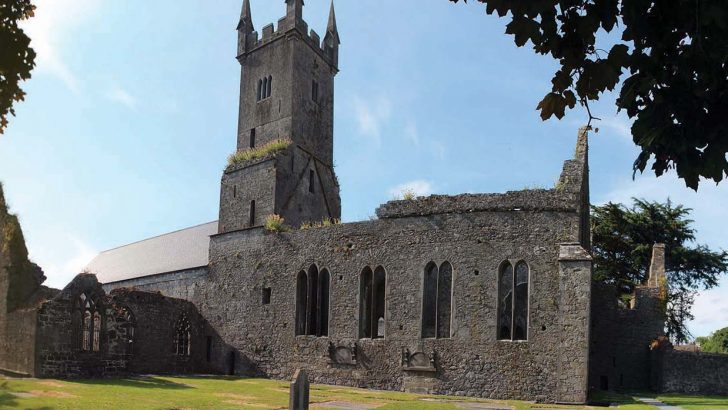The World of Books
by the Books Editor
Recently a friend of mine asked me what the visitation of the Black Death to Ireland at the end of the 1340s was like. He was wondering how it compared to the present Covid-19 infection.
Actually, a very vivid record exists: it was first printed coincidently in Dublin in 1849, when the country was trying to recover from another terrible scourge – the Great Famine.
It is to be found in a chronicle compiled in the southeast of Ireland. It was composed by a Franciscan who over the centuries speaks well for himself.
“And I, Brother John Clyn, of the Order of Friars Minor and of the convent of Kilkenny, wrote in this book those notable things which happened in my time, which I saw with my own eyes, or which I learned from people worthy of belief. And in case things which should be remembered perish with time and vanish from the memory of those who are to come after us, I, seeing so many evils and the whole world, as it were, placed within the grasp of the evil one, being myself as if among the dead, waiting for death to visit me, have put into writing truthfully all the things that I have heard. And, lest the writing should perish with the writer and the work fail with the labourer, I leave parchments to continue this work, if perchance any man survive and any of the race of Adam escape this pestilence and carry on the work which I have begun.”
Peroration
John Clyn added two words to his peroration: magna karistia – ‘great dearth’, then he joined his fellows; another hand briefly added at some later date, ‘Here it seems that the author died.’
[From Friar John Clyn, Annals of Ireland, ed. R. Butler (Dublin: Irish Archaeological Society 1849), p. 37). A new edition, edited by Bernadette Williams, appeared in 2007.]
Surprisingly medieval historians were reluctant to deal with the Black Death as a whole, in a synthetic manner, preferring, as is often the case, more narrowly focused studies. Indeed a more recent writer, Philip Ziegler, was surprised to find in 1969 that no general study of the Black Death had been written since Cardinal Francis Aidan Gasquet wrote The Great Pestilence in 1893.
There is a small mystery about the date of the Black Death’s arrival in Ireland. It had certainly reached Paris by the summer of 1348. But Chester, only in June 1349. The disease began to fade and by the early 1350s people felt it was gone – though there were later brief outbreaks. However, Friar Clyn down in Kilkenny insists that it had reached Ireland directly from France at an earlier date than in England. He was categoric: referring to 1348, he records: “…in the months of September and October, bishops, prelates, priests, friars, noblemen and others, women as well as men, came in great numbers from every part of Ireland to the pilgrimage centre of That Molyngis [Teach Molinge , now St Mullins, on the River Barrow]. So great were their numbers that on many days it was possible to see thousands of people flocking there; some through devotion but others (the majority indeed) through fear of the plague, which then was very prevalent. It began near Dublin at Howth and at Drogheda. These cities were almost entirely destroyed and emptied of inhabitants so that in Dublin alone, between the beginning of August and Christmas, fourteen thousand people died.”
Yet in August 1349 Richard Fitzralph, Archbishop of Armagh told the Pope during a visit to Avignon that the plague had destroyed two thirds of the English nation, but had not yet done any conspicuous harm to the Irish or the Scots.
Evidence
Mr Ziegler dolefully observes about Brother Clyn. “Even if no other evidence survived from Ireland, John Clyn’s cry would show how painfully the country must have suffered. He was a lonely, frightened man, who had already witnessed the death-agonies of almost all the other members of his house and now sought to record their end for posterity before the oblivion of death swept over all Kilkenny and all the country – even all the world. Whether anyone would live to read his words he did not know, hardly dared even wonder, but that instinct which leads men to seek to communicate with their unknown successors, whoever they might be and whatever they might be doing, now drove him on to write his chronicle, a memorial to the terror and grief of those who were still alive.”
***
The answer to my friend seems to be that so far Covid-19 (at the moment of writing) has had 5,598 plus victims in the island of Ireland. So back in 1340s when the population might only have been somewhat more than a half million or so – the Black Death proportionally killed far more people here than Covid-19 will do.
In our current pain this may be hard to accept. Other parts of the world are far worse off. But in 2021 with Covid-19 we are luckier than we think we are.


 Peter Costello
Peter Costello The ruins of the medieval Franciscan friary in Kilkenny.
Photo: Ruhrfisch.
The ruins of the medieval Franciscan friary in Kilkenny.
Photo: Ruhrfisch. 